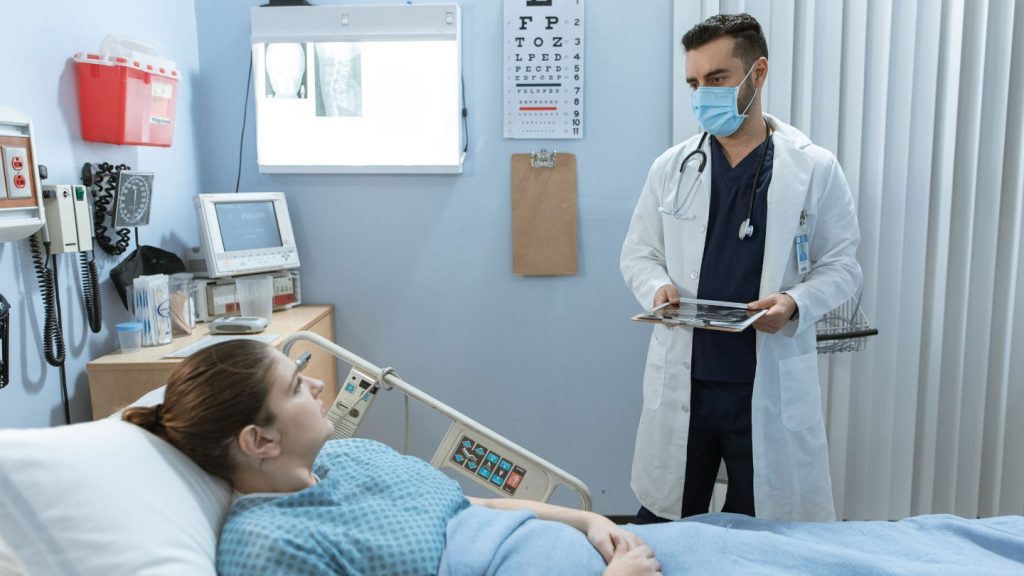
Recovering from Gallbladder Surgery: Your Step-by-Step Guide to a Smooth Recovery
Recovering from gallbladder surgery can be challenging, but knowing what to expect can ease the process. This blog covers immediate post-surgery care, pain management, dietary adjustments, and monitoring for complications. By following these steps, you can ensure a smooth recovery and return to your daily activities.
Key Takeaways
- Gallbladder removal (cholecystectomy) can be performed via laparoscopic or open techniques, influencing recovery time and post-operative care.
- Post-surgery care involves managing pain, monitoring for complications, and gradually increasing activities while adhering to dietary adjustments for optimal recovery.
- Emotional support and follow-up appointments are essential for addressing recovery progress and ensuring both physical and mental well-being.
Understanding Gallbladder Surgery
The surgical procedure known as gallbladder removal, or cholecystectomy, is frequently undertaken to alleviate severe abdominal pain and other symptoms associated with conditions like gallstones and inflamed gallbladders. This organ serves the crucial role of storing bile from the liver but can sometimes develop stones that obstruct the flow in bile ducts, leading to significant health problems necessitating its removal.
At WellStar Comprehensive Bariatric Services, we specialize in advanced techniques like laparoscopic and robotic cholecystectomy to provide minimally invasive options that support faster recovery and enhanced outcomes. Laparoscopic cholecystectomy involves small incisions through which a video camera guides surgeons during the operation, reducing pain and recovery time. Many patients can return home the same day.
Alternatively, an open cholecystectomy may be necessary in cases where laparoscopic methods are unsuitable or complications arise. Our expertise ensures that whether your surgery is minimally invasive or open, you’ll receive exceptional care tailored to your needs. Understanding these surgical approaches helps patients anticipate and prepare for their recovery journey.
Why is Gallbladder Removal Necessary?
Gallbladder removal becomes necessary when the gallbladder is diseased or damaged, leading to symptoms such as abdominal pain, nausea, and vomiting. The most common reason for this surgical procedure is the presence of gallstones. These small, hard deposits can block the bile ducts, causing significant pain and potentially leading to more severe health issues.
Other conditions that may require gallbladder removal include gallbladder inflammation (cholecystitis), gallbladder cancer, and bile duct cancer. These conditions can cause severe discomfort and pose serious health risks if left untreated. By removing the gallbladder, these symptoms can be alleviated, and the risk of further complications can be minimized, ultimately improving the patient’s quality of life.
Immediate Post-Surgery Care

In the initial hours following your gallbladder surgery, attentive care is crucial for a seamless recovery process. In the recovery room, medical professionals will diligently monitor your critical signs and general health status. During this time, they’ll also address any immediate post-anesthesia symptoms you might experience, such as nausea or vomiting, while ensuring that any discomfort you feel is effectively managed.
As soon as stability is achieved, attention turns to encouraging early mobility. Prompt physical activity post-surgery plays a vital role—it enhances blood flow, minimizes the chances of developing blood clots, and accelerates your overall healing process. Observing these first steps meticulously, along with strict adherence to additional guidance from your healthcare team, paves the way for an efficient transition back home after surgery.
Pain Management Techniques
Managing pain after surgery is critical for recovery. Patients may experience discomfort at the incision site, shoulder pain from the gas used in laparoscopic surgeries, or throat soreness from the breathing tube used during anesthesia. These temporary discomforts are effectively managed with proper care and pain medication guidance from your care team.
To address post-surgical pain, we employ a range of strategies, including over-the-counter pain medicine, as well as prescribed options tailored to individual needs. Our holistic approach also incorporates relaxation techniques, deep breathing exercises, and mindfulness practices to alleviate stress and reduce pain naturally. With our expertise, you can confidently navigate this phase of recovery.
Monitoring for Complications
Most patients tend to heal with minimal complications. It is important to be aware of potential issues that may arise. Bile leakage stands out as a serious complication that could lead to intense abdominal pain and potentially necessitate Medical treatment. It’s crucial for individuals to keep an eye out for signs such as fever, ongoing pain, or abnormal redness and swelling near surgical cuts since these symptoms might signal an infection.
In the event of experiencing acute symptoms or observing substantial alterations in your health status, it is vital to promptly get in touch with your healthcare provider. Prompt recognition and management are key in preventing small problems from escalating into significant health risks.
Transitioning to Home Care
Making the move to home care marks a crucial phase in your recuperation process. It is critical that you adhere strictly to the guidelines set out by your healthcare provider for a seamless recovery period. In the initial one or two weeks, it’s important to refrain from engaging in heavy lifting and intense physical exertion so as not to hinder your body’s healing process. Promptly beginning light activity like strolling within your residence can assist in enhancing blood flow and mitigating potential complications with blood clots.
Engaging in deep breathing exercises is beneficial for lowering pneumonia risks while aiding overall rehabilitation. Diligently monitoring how you manage wound care and complying with the instructions provided will also contribute significantly to an effective transition from hospitalization back into home-based convalescence.
Wound Care and Hygiene
It is essential to manage your wound with care in order to ward off infections and aid the healing process. Ensuring that the surgical site remains clean and dry, coupled with adhering strictly to your surgeon’s guidance on when and how to change dressings, is critical. Overlooking these steps can result in infections that hinder timely recovery.
Be vigilant for signs of infection at the wound site, including heightened redness, swelling, or any unusual discharge. Should you observe any such symptoms, it’s imperative that you act swiftly by getting in touch with your healthcare provider immediately. Faithful adherence to correct wound care protocols markedly lowers the risk of complications and contributes positively towards a seamless healing journey.
Gradually Increasing Activity
Gradually escalating your activity levels is crucial for a favorable recovery outcome. Commence with simple tasks, like ambling within your residence following discharge, to enhance blood flow and stave off issues such as blood clots.
The majority of patients are capable of resuming their typical daily activities, encompassing professional or educational responsibilities, if they are not physically strenuous, typically within one to two weeks after the procedure. It’s important to steer clear of arduous physical work and intense workouts for at least four to six weeks in order to avoid exertion during the healing process.
Incorporating regular yet brief walking sessions is an outstanding strategy for progressively reintroducing activity into your lifestyle post-recovery.
Dietary Adjustments After Surgery

Adjusting your diet is vital for recovery and long-term digestive health after gallbladder surgery. We understand the importance of tailoring nutritional advice to support your healing. Avoiding fatty foods, large portions, and items high in sugar or caffeine can help minimize digestive discomfort and promote better recovery outcomes.
Our dietitians provide personalized guidance, recommending the gradual introduction of high-fiber foods like fruits and vegetables to stabilize digestion and improve bowel movements. Starting with clear liquids and progressing to a low-fat diet ensures that your digestive system adjusts smoothly. These tailored adjustments empower patients to maintain digestive health and embrace lasting dietary improvements.
Initial Diet: What to Eat and Avoid
It is advisable to initiate your post-surgical nutrition with a diet consisting of clear liquids. As the body embarks on its recovery, you should slowly introduce a low-fat regimen into your meals. Including high-fiber edibles such as vegetables and fruits can significantly aid in promoting the healing process.
To prevent disruption of digestion and extend the duration of recuperation, it’s essential to steer clear of foods that are rich in fat or sugar content and avoid fried items. For optimal digestion and health benefits during this period, maintain a dietary structure where fats comprise no more than 30% of your total caloric intake.
Long-Term Dietary Changes
After having your gallbladder removed, it’s crucial to adhere to dietary modifications for sustained digestive well-being. Opting for foods that are high in fiber and low in fat can assist in regulating bowel habits and averting gastrointestinal complications.
Should ongoing digestive problems occur, some people might require additional alterations to their diet or even medical treatment. Collaborating with a healthcare provider enables you to customize your nutritional intake according to your unique requirements, which is vital for maintaining long-term digestive health.
Managing Digestive Changes
Following the removal of the gallbladder, the majority of patients typically do not encounter substantial problems with their digestion. Nevertheless, there is a possibility that some individuals may contend with issues like diarrhea or loose stools as a result of bile being directly discharged into the intestines. This uninterrupted stream of bile can act as a laxative and give rise to these symptoms, which might suggest post-cholecystectomy syndrome, including unexplained pain syndromes.
In order to address these digestive changes, it’s advisable to slowly incorporate more soluble fiber into your diet since it can aid in normalizing bowel movements. Should these symptoms persist or amplify in severity, communicating with your healthcare provider about your bowel habits becomes essential for exploring possible treatment options.
Emotional and Mental Health Support

Recovery encompasses not only physical aspects but also emotional and mental ones. Employing self-care practices such as mindfulness, meditation, and deep breathing can notably improve your emotional health while recovering.
It’s critical to seek support and effectively convey both your physical and emotional needs to your loved ones as well as the healthcare team assisting you. Addressing these facets is crucial since emotional wellness has a substantial effect on overall healing progress.
Follow-Up Appointments and Long-Term Care
Follow-up appointments play an essential role in your recovery journey. At WellStar Comprehensive Bariatric Services, we prioritize these visits to assess healing, address any concerns, and adjust care plans as needed. Our team uses these sessions to monitor your progress and provide resources that enhance your recovery experience.
We ensure easy access to expert care through in-person consultations. Keeping a journal of symptoms and progress can make these appointments more productive. Be proactive in discussing your recovery, as our specialists are here to guide you toward optimal health and long-term wellness.
Summary
Recovering from gallbladder surgery involves several essential steps, from immediate post-surgery care to long-term lifestyle adjustments. By understanding the surgical procedure, effectively managing pain, monitoring for complications, and making necessary dietary changes, you can facilitate a smooth recovery. Emotional and mental health support, along with diligent follow-up care, are also critical for a complete recovery.
At Wellstar Comprehensive Bariatric Services, we specialize in gallbladder surgery serving Cobb County, Marietta, Austell, Smyrna, LaGrange, and other locations across Georgia. Our comprehensive services are tailored to support you at every step of your recovery journey, ensuring you achieve a smooth recovery and maintain long-term health. Contact us today to find out how we can assist you in your recovery.
Frequently Asked Questions
What are the dietary restrictions after gallbladder surgery?
After surgery, beginning with a clear liquid diet is essential, and slowly transitioning to a diet low in fat. Avoiding foods that are high in fat, fried, or rich in sugar will aid your digestive system and facilitate the recovery process.
How soon can I return to work after gallbladder surgery?
You can typically return to work within a week or two if your job is sedentary, but it’s important to avoid heavy lifting and strenuous activities for at least 4-6 weeks afterward.
What should I do if I experience severe pain after gallbladder surgery?
If you experience severe pain after gallbladder surgery, it’s crucial to contact your healthcare provider immediately, as this may indicate complications such as bile leakage or infection. Prompt medical attention is essential for your recovery.
How long does it take to recover from gallbladder surgery?
Recovery from gallbladder surgery generally takes a few days for laparoscopic procedures and several weeks for open surgery. Adhering to your healthcare provider’s recommendations is crucial for a smooth recovery.
